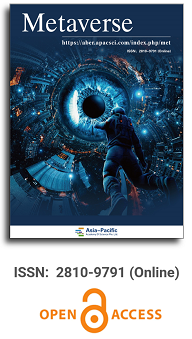
Asia Pacific Academy of Science Pte. Ltd. (APACSCI) specializes in international journal publishing. APACSCI adopts the open access publishing model and provides an important communication bridge for academic groups whose interest fields include engineering, technology, medicine, computer, mathematics, agriculture and forestry, and environment.



Application of augmented reality, gamification and m-learning
Vol 3, Issue 2, 2022
Download PDF
Abstract
Augmented reality, gamification and m-learning occupy today an important place in education, given the advantages that the use of mobile technologies has brought, independently or in combination with other technological scenarios and different devices that affect the teaching and learning of disciplines or that serve as a bridge to improve various processes mediated by ICT in teaching and/or learning. In this sense, the article presented here shows an analytical study that was developed under an exploratory, descriptive and interpretative methodology of the categories augmented reality, gamification and m-learning, based on a characterization in the databases, a literature review was conducted in the main databases such as Science direct, Scopus and web Science, obtaining 100 reference articles. Thus, it was found that these three categories determined as teaching strategies significantly influence motivation, interest in knowledge, retention and understanding of information for the development of teaching and learning processes. The method used allowed to develop the description of the panorama about the use of augmented reality, m-learning and gamification in elementary, middle and higher education.
Keywords
References
- Almenara JC, Osuna JB, Obrador M. Augmented reality applied to the teaching of medicine. Medical Education 2017; 18: 203–208.
- Coimbra MT, Cardoso T, Mateus A. Augmented reality: An enhancer for higher education students in math’s learning? Procedia Computer Science 2015; 67: 332–339.
- Rodriguez-Cardoso Ó, Ballesteros-Ballesteros V, Lozano-Forero S. Digital technologies for innovation in education: A theoretical review of learning processes mediated by mobile devices. Thought and Action 2019; (28): 83–103.
- Huang T, Chen C, Chou Y. Animating eco-education: To see, feel, and discover in an augment reality-based experiential learning environment. Computers and Education 2016; 96: 72–82.
- Cheng C, Su C. A mobile gamification learning system for improving the learning motivation and achievements. Journal of Computer Assisted Learning 2015; 31: 268–286.
- Alhammad MM, Moreno AM. Gamification in software engineering education: A systematic mapping. Journal of Systems and Software 2018; 141: 131–150.
- Swanson JA. Assessing the effectiveness of the use of mobile technology in a collegiate course: A case study in m-learning. Technology, Knowledge and Learning 2018; 25: 1–20.
- Mendes LF, Pedro G, Barbosa C, Das Nebes Santos CM. A critical review of mobile learning integration in formal educational contexts. International Journal of Educational Technology in Higher Education 2018; 15(10).
- Jamali SSS, Shiratuddin MF, Wong KW, Oskam CL. Utilising mobile-augmented reality for learning human anatomy. Procedia-Social and Behavioral Sciences 2015; 197: 659–668.
- Lee K. Augmented reality in education and training. Tech Trends 2012; 56: 13–21.
- Okimoto ML, Okimoto PC, Goldbach CE. User experience in augmented reality applied to the welding education. Procedia Manufacturing 2015; 3: 6223–6227.
- Önal N, Ibili E, Çaliskan E. Does teaching geometry with augmented reality affect the technology acceptance of elementary school mathematics teacher candidates? Online Submission 2017; 8: 151–163.
- Majid NA, Mohammed H, Sulaiman R. Students’ perception of mobile augmented reality applications in learning computer organization. Procedia-Social and Behavioral Sciences 2015; 176: 111–116.
- Chang S, Hwang G. Impacts of an augmented reality-based flipped learning guiding approach on students’ scientific project performance and perceptions. Computers & Education 2018; 125: 226–239.
- Estapa A, Nadolny L. The effect of an augmented reality enhanced mathematics lesson on student achievement and motivation. Journal of STEM education 2015; 16: 40–48.
- Hsu T. Learning English with augmented reality: Do learning styles matter? Computers and education 2017; 106: 137–149.
- Alhumaidan H, Lo K, Selby A. Co-designing with children a collaborative augmented reality book based on a primary school textbook. International Journal of Child-Computer Interaction 2018; 15: 24–36.
- Iftene A, Trandabăţ D. Enhancing the attractiveness of learning through augmented reality. Procedia Computer Science 2018; 126: 166–175.
- Joo-Nagata J, Abad FM, Giner JGB, García-Peñalvo FJ. Augmented reality and pedestrian navigation through its implementation in m-learning and e-learning: Evaluation of an educational program in Chile. Computers & Education 2017; 111: 1–17.
- Cadena Beltrán AF. Augmented reality in the development of the Colombian post-conflict. Noria Investigación y Educación 2020; 1(5): 54–76.
- Ibanez MB, Delgado-Kloos C. Augmented reality for STEM learning: A systematic review. Computers Education 2018; 123: 109–123.
- Bacca Acosta JL, Baldiris Navarro SM, Fabregat Gesa R, Kinshuk SG. Mobile augmented reality in vocational education and training. Procedia Computer Science 2015; 75: 49–58.
- Chen C, Lee I, Lin L. Augmented reality-based video-modeling storybook of nonverbal facial cues for children with autism spectrum disorder to improve their perceptions and judgments of facial expressions and emotions. Annals of Anatomy 2016; 215: 71–77.
- Bal E, Bicen H. Computer hardware course application through augmented reality and QR code integration: Achievement levels and views of students. Procedia computer science 2016; 102: 267–272.
- Turkan Y, Radkowski R, Karabulut-Ilgu A, et al. Mobile augmented reality for teaching structural analysis. Advanced Engineering Informatics 2017; 34: 90–100.
- Van Roy R, Zaman B. Need-supporting gamification in education: An assessment of motivational effects over time. Computers & Education 2018; 127: 283–297.
- Martí-Parreño J, Seguí-Mas D, Seguí-Mas E. Teachers’ attitude towards and actual use of gamification. Procedia-Social and Behavioral Sciences 2016; 228: 682–688.
- Garcia F, Pedreira O, Piattini M, Cerdeira P. A framework for gamification in software engineering. Journal of Systems and Software 2017; 132: 21–40.
- Kusuma GP, Wigati EK, Utomo Y, Suryapranata LKKP. Analysis of gamification models in education using MDA framework. Procedia Computer Science 2018; 135: 385–392.
- Ge Z. The impact of a forfeit-or-prize gamified teaching on e-learners’ learning performance. Computers & Education 2018; 126: 143–152.
- Perry B. Gamifying French language learning: A case study examining a quest-based, augmented reality mobile learning-tool. Procedia - Social and Behavioral Sciences 2015; 174: 2308–2315.
- Jagušt T, Botički I, So HJ. Examining competitive, collaborative and adaptive gamification in young learners’ math learning. Computers & Education 2018; 125: 444–457.
- Manuela A, Tiago O, Fernando B, Marco P. Gamification: A key determinant of massive open online course (MOOC) success. Information & Management 2018; 56: 39–54.
- Kasurinen J, Knutas A. Publication trends in gamification: a systematic mapping study. Computer Science Review 2018; 27: 33–44.
- Al-Emran M, Mezhuyev V, Kamaludin A. Technology acceptance model in m-learning context: A systematic review. Computers & Education 2018; 125: 389–412.
- Sabah NM. Exploring students’ awareness and perceptions: Influencing factors and individual differences driving m-learning adoption. Computers in Human Behavior 2016; 65: 522–533.
- Briz-Ponce L, Pereira A, Carvalho L, et al. Learning with mobile technologies—Students’ behavior. Computers in Human Behavior 2017; 72: 612–620.
- Liu Y, Rao J, Liu P, Zhou P (editors). An empirical study on factors influencing students’ intention on m- learning in middle school of China. IEEE 18th International Conference on Advanced Learning Technologies (ICALT). Mumbai; 2018. p. 79–83.
- Spiegel A, Rodriguez G. Students at university have mobile technologies. Do they do m-learning? Procedia-Social and Behavioral Sciences 2016; 217: 846–850.
- Ballesteros-Ballesteros V, Rodríguez-Cardoso Ó. Mobile learning in higher education: An experience from engineering education. Scientific Journal 2020; (38): 243–257.
- Tsai CH, Huang JY. Augmented reality display based on user behavior. Computer Standards & Interfaces 2018; 55: 171–181.
Supporting Agencies
Copyright (c) 2022 Danna-Camila Claros-Perdomo, Edwin-Eduardo Millán-Rojas, Adriana-Patricia Gallego-Torres

This work is licensed under a Creative Commons Attribution 4.0 International License.

This site is licensed under a Creative Commons Attribution 4.0 International License (CC BY 4.0).

Prof. Zhigeng Pan
Director, Institute for Metaverse, Nanjing University of Information Science & Technology, China

Prof. Jianrong Tan
Academician, Chinese Academy of Engineering, China
Conference Time
December 15-18, 2025
Conference Venue
Hong Kong Convention and Exhibition Center (HKCEC)
...
Metaverse Scientist Forum No.3 was successfully held on April 22, 2025, from 19:00 to 20:30 (Beijing Time)...
We received the Scopus notification on April 19th, confirming that the journal has been successfully indexed by Scopus...
We are pleased to announce that we have updated the requirements for manuscript figures in the submission guidelines. Manuscripts submitted after April 15, 2025 are required to strictly adhere to the change. These updates are aimed at ensuring the highest quality of visual content in our publications and enhancing the overall readability and impact of your research. For more details, please find it in sumissions...






.jpg)
.jpg)

